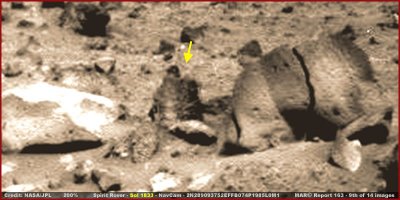I'm fascinated by pareidolia, the human ability to see order even when there is none, as manifested by seeing Jesus in your burrito and other such stuff. And largely with the aid of the Internet, a new world of such possibilities has opened up.
You can find sites that take weird artifacts of NASA's sun-observing cameras and declare them "solar cruisers," as in giant UFOs. I have lost track of (but wish I could re-find) a gentleman who believes that ancient rocks were painted with a sort of photo emulsion, offering us snapshots of things like the deck of Noah's Ark. And there are folks who peruse NASA images from the moon and Mars endlessly, finding slight anomalies and (usually) declaring them evidence of ancient civilizations, a habit begun in earnest with the pre-Internet "face on Mars" that turned out to be classic pareidolia.
The beauty of such stuff, of course, is that it all falls prey to the cry of the pseudoscientist: "You can't disprove it!" Of course, science doesn't and couldn't work that way. I mean, they have yet to disprove my theory that Michael McDonald altered his appearance in the early '80s and revitalized his career with a new name: Billy Ocean. I mean, go ahead, try to disprove it. I rest my case.
If scientists took up such stuff, they'd obviously never get anywhere. Just like the pitiful state of Internet "debate," Internet theorizing is infinite and largely meaningless. Because, like always, when scientists roll their eyes, the theorists go wild with accusations of cover-up and lack of respect.
Then again, there's Charles Forte, who lent a certain respect to such ideas, at least as long as the theorists in question used the actual empirical model to study a phenomenon. But that kind of restraint is hardly the prevailing model, even when someone like the Mars researcher mentioned below turns up something really interesting, which of course does happen.
An update may follow, but all of this came up because I just perused such a site, where our theorist (who isn't to be fair, getting too crazy, even if the premise is a bit suspect) proposes that Mars may be inhabited–by moving rocks.
ADDITIONAL: The whole psuedoscience trope is very well illustrated in this excerpt from the page in question, which, I should point out, refers one to the originator of this "discovery," a website solely devoted to looking at Mars pictures to find anomalies. Not that a discovery through such an unusual channel is impossible by any means, but it's unlikely that an armchair researcher is going to outdo NASA, until and unless the kind of conspiracy theories they are convinced of turns out to be true:
There are fantastic possibilities here. Something is going on right in front of the cameras. Even if it isn’t life, isn’t it still worth a closer look? Isn’t that why we went to Mars? Perhaps one reason NASA scientists won’t look is because it has been ingrained into their collective psyche that surface life can’t exist.
How many scientists have been afraid to look at strange events because even a public hint of interest could destroy their careers? Could that be what we have here? Or is it something else… maybe a rationality is used. Maybe NASA thinks even the hint of higher life on Mars should be hidden from the public.
Should NASA or any agency paid for by tax dollars withhold important knowledge because some small groups may react irrationally? Would the public go nuts if NASA announced there was animal life forms on Mars? …I don’t think so.
It has indeed been ingrained in scientists that "surface life" can't exist on Mars because no evidence of any kind has ever pointed to that possibility, and science isn't religion. But everybody has to have a raison d'etre, no? And this logic is problematic: "Would the public go nuts if NASA announced there was animal life forms on Mars? …I don’t think so."
Then why assume there is a conspiracy? What scientist wouldn't want to be the one who successfully investigated the anomalous and made a career- and culture-altering discovery? These guys aren't magicians protecting secret knowledge the rest of us can't handle.
What I find most fascinating about such things is the rapidity of the progression from "I see something weird" to the assumption that it's worth investigation and subject to cover-up or willful lack of investigation–as if the investigator has no burden of proof for extraordinary claims. There are clear problems of a very basic sort that plague these kinds of claims, from artifacts produced when working with digital images to things like, well, this–
The entire background of these images is different, as is the aspect ratio, as is the zoom, as is the angle. (Either that or there are magical growing rocks there too.) The arrow points to a rock which supposedly has moved (under its own power) out of frame in the next shot.


And the third one is taken from a very different angle:

I'm reminded of the awesome scene in Father Ted in which Ted holds up a plastic cow to Dougal, and says "OK, one last time. These are small." Then he points to cows outside the window: "But the ones out there are far away. Small… far away… ah, forget it!" Dougal just shakes his head with a foolish grin.
And then there's the widespread problem of ignorance about physics. Conditions on the surface of Mars differ wildly from what we're used to–liquid water, for instance, unless it's a particular briny solution, would evaporate with stunning speed there. Things just don't work the same way. A few counterintuitive photos taken on another planet don't necessarily mean a conspiracy. Heck, maybe there really is a conspiracy, but this doesn't prove it.
But then again, if people kept that stuff in mind, the Internet wouldn't be half as interesting as it is. Just check out the Mars Anomaly Research site and you'll get a fascinating eyeful. And just for good measure, this Mars crew also reports on the moon hoax, a maddening, oft-debunked example of ignorance about physics and optics.
You may have a hard time getting to everything there right now, because the website is experiencing difficulties accessing certain pages:
The website is currently experiencing problems accessing only the reports function while everything else works. This is allegedly because the host server was experiencing excessive traffic hits via this function. At first this seemed straight forward. However, due to the arbitrariness of what is transpiring in follow-up, now I'm not so sure. I'm beginning to suspect this work's adversaries may have a hand in this. The timing of this may have been precipitated in part by my recent #38 commentary below committing to a release timing for the book evidence as well as of course the Planetary Truth Project along with it, Also there is an article on this work appearing in a Belgium newspaper popular in Europe that they may expect to produce more traffic. They may be trying to blunt the media exposure thinking that public short attention spans will prevail. If so, this may require a drawn out period to counter and so the website may be down for a while. It can't be helped because I will not give in to such manipulation. Unfortunately, it goes with the territory.
Yes, apparently it does.
ADDITIONAL ADDITIONAL:
Andrew Basiago, head of of the Mars Anomaly Research Society (not the same organization as the originator of the above, which is Mars Anomaly Research, and not to be confused with the People's Front of Judea), has gone yet farther in what he sees in panoramic photos of the Martian surface released by NASA. His book addressing the existence of life on Mars can be examined here.
An excerpt from an article about his work:
The five types of humanoid beings thus far identified on Mars include: human beings, like those on Earth; beings with bulbous heads and spindly bodies, like the alien beings found in the UFO literature; transparent beings, like glass totems; forms that are all head; and hybrids that combine human traits with insect and lizard ones.
The hybrids include such odd creatures as the Scorpion Man, whose bright turquoise color matches the bright turquoise rocks of Mars. The image of the Scorpion Man prompted a clamor of recognition from the audience when Basiago showed his photographs of life forms on Mars that have never been seen before on Earth. “I see it! I see it!” one woman exclaimed excitedly.
MARS: A sendak on MarsThe animals on Mars include species that presently exist on Earth, such as elephants, platypuses, horses, cows, frogs, turtles, slugs, snakes, and snails; animals that once existed on Earth but are now extinct, such as plesiosaurs, which are ubiquitous on Mars but did not survive the K-T extinction on Earth; and animals that have neverexisted on Earth but combine the traits of two or more Earth species.
Make of it what you will (which seems to be the order of the day).



